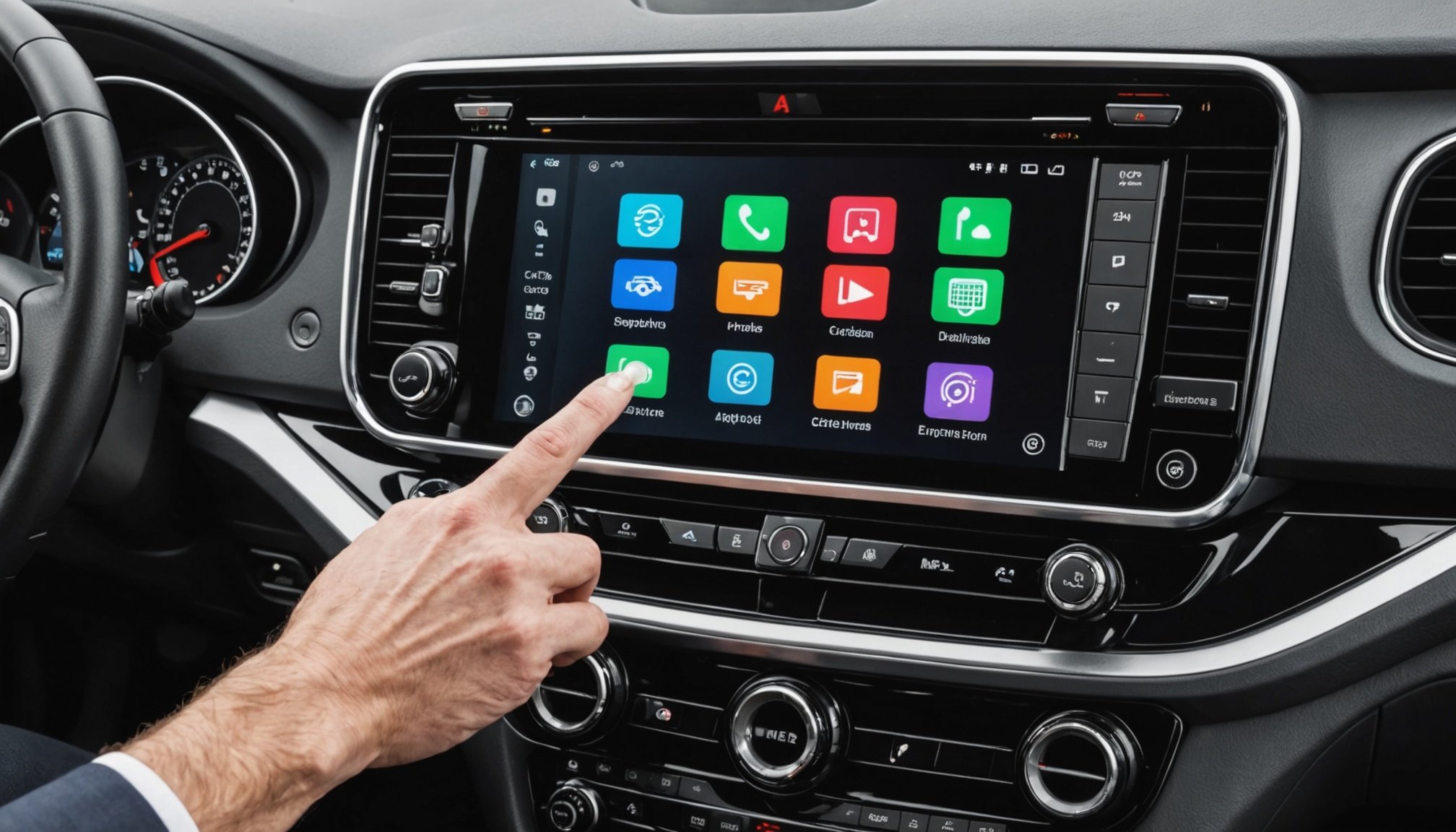Understanding Infotainment System Upgrades
In recent years, infotainment upgrades have become increasingly popular as advancements in car technology offer new opportunities for enhancing driving experiences. These systems integrate entertainment, navigation, and communication functions into an all-in-one platform within vehicles. Understanding the intricacies of such systems is crucial for drivers aiming to boost both their convenience and connectivity on the road.
When considering infotainment systems upgrades, it’s important to explore the variety of options available. Popular types include satellite radio installations, touch-screen controls, and smartphone integration features such as Apple CarPlay or Android Auto. These upgrades enhance both the accessibility and efficiency of in-car features, making commutes more enjoyable and less cumbersome.
Also to read : Boost your car”s a/c performance: key strategies for thriving in the uk climate
The importance of upgrading car infotainment systems is not solely about comfort; safety and efficiency are paramount. Newer systems often incorporate voice control and hands-free functionalities. These features decrease the need for physical interaction, thus minimizing distractions and promoting safer driving practices. Additionally, modern infotainment devices frequently come with updated navigation systems, providing real-time traffic data and alternative routes to save time and fuel.
Evaluating the potential benefits and functionalities of infotainment upgrades can lead to both improved safety and a more connected driving experience. As technology continues to evolve, these systems offer practical solutions to common driving challenges.
In parallel : Your guide to uk window tinting regulations: finding the perfect tint levels for your car
Legal Considerations for Upgrading Infotainment Systems
Upgrading your vehicle’s infotainment system in the United Kingdom requires adhering to specific legal requirements to avoid potential penalties. Understanding UK road regulations related to infotainment systems is crucial for ensuring compliance. These regulations often dictate the allowable features and installations to prevent distractions that could impair road safety.
The legal framework emphasizes the importance of compliance with standards to ensure that all infotainment upgrades do not hinder a driver’s ability to maintain control of the vehicle. Therefore, it is essential to consider whether the new system permits interactions that remain within legal limits. Features like voice control and hands-free operations are favourable under these regulations as they support safer driving.
Failing to comply with these requirements can lead to significant consequences, including fines and restrictions on vehicle use. More importantly, non-compliance can impact safety, increasing distractions and risk on the road. Consulting the latest regulations can save time and prevent costly mistakes when planning to upgrade your infotainment system. Seeking expert advice or professional installation services can further ensure that your vehicle remains safe and legally sound while benefiting from modern technology enhancements.
Safety Tips for Car Infotainment Upgrades
Upgrading your car’s infotainment system can greatly enhance your driving experience, but it’s crucial to prioritise safety throughout the process. Proper planning and execution will ensure that these technologies serve you well without compromising your vehicle safety.
Preparing for Installation
Before starting, gather all necessary tools. A basic toolkit typically includes screwdrivers and wire strippers. Understanding your vehicle’s existing system is also vital. Check the manual to familiarise yourself with its layout and connections. This preparation helps create a seamless transition to your new infotainment upgrade.
During the Installation
Focus on electrical safety to avoid mishaps. Disconnect the vehicle battery to prevent shocks or damage. When removing old units, cautiously handle all components and wires. It’s essential to maintain concentration, ensuring minimal distractions during this phase. Accurate removal safeguards both the vehicle and the new equipment.
Post-Installation Safety Checks
Once installed, thoroughly test the infotainment system. Check all functionalities, such as audio, navigation, and connectivity features. Adjust the settings to minimise distractions while driving. Familiarise yourself with new features, as comprehensive knowledge assists in safe operation and maximises the benefits of your upgraded car technology.
Recommended Infotainment Products Compliant with UK Regulations
Expanding your vehicle’s infotainment capabilities involves selecting compatible products that meet UK regulations while enhancing functionality. Navigating the myriad of options can be challenging, but understanding which features matter most can simplify the decision process.
Optimal infotainment systems blend innovation with legality, offering modern upgrades that adhere to stringent legal requirements. Look for products featuring voice control, seamless smartphone integration, and hands-free functionality, all of which enhance safety by reducing distractions.
Consumer electronics reviews offer insight into top-rated systems. Brands like Pioneer, Sony, and Alpine are praised for their intuitive interfaces and regulatory compliance. User feedback highlights the importance of fast and reliable connectivity, as well as display clarity under different lighting conditions.
When evaluating recommendations, prioritize products that not only align with UK laws but also support versatile features like multi-device pairing and real-time navigation updates. Engaging knowledgeable retailers and consulting installation experts can ensure compatibility with your specific vehicle model and needs.
Making informed choices about infotainment systems involves balancing compliance with technology benefits. Keep abreast of new product releases and user experiences to stay updated on the best options in the market.
Visual Guides and Diagrams for Installation
Navigating the installation guide via detailed visual aids can significantly simplify the upgrade process of your car’s infotainment system. Illustrated instructions provide clarity by showcasing each step meticulously.
Step-by-Step Visual Instructions
Diagrams offer an essential overview of the upgrade process from beginning to end. Highlighting key components like connectors and wiring positions helps avoid common errors. This offers a clear pathway to achieving a seamless integration of your new system safely. Visuals illustrate necessary precautions, enabling a straightforward transition.
Being aware of these visual cues can prevent installation pitfalls and promote a smooth setup process.
Infographic – Legal Compliance Checklist
To ensure that your upgrade sits comfortably within the legal requirements, a compliance infographic is invaluable. This visual not only summarises crucial standards but also emphasizes steps to ensure conformity with UK road regulations. By following these checks carefully, you can ensure your infotainment system upgrade adheres completely to the law.
Visual guides cater to both novices and experienced individuals, offering inclusive step-by-step assistance. With these precautions and guides, you are equipped to approach your infotainment system upgrade confidently and legally.
Frequently Asked Questions About Upgrading Infotainment Systems
Upgrading your car’s infotainment system can seem daunting, especially with numerous FAQs around the process. Below, we address some common installation questions to guide you through a successful upgrade.
Q: Can I install an infotainment system myself, or should I hire a professional?
A: While some enthusiasts opt for DIY installation, hiring a professional ensures compliance with UK road regulations and prevents common errors. A professional can guarantee the system is set up correctly and efficiently.
Q: How do I troubleshoot issues after upgrading?
A: Start by checking the connectivity of your infotainment system. Ensure all wires are firmly connected. Refer to the installation guide for troubleshooting support, focusing on error messages or functionality lapses. If problems persist, consulting a specialist may be necessary.
Q: What steps should I follow if the new system doesn’t function properly?
A: Double-check all cables and connections. Sometimes a simple reset or updating the system software solves unexpected issues. For persistent malfunctions, contact customer support for brand-specific remedies. Understanding how your upgraded system interacts with your vehicle can significantly enhance operation and safety.






